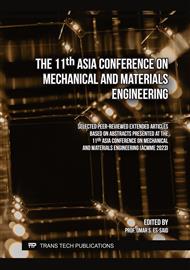[1]
Liu, Y., et al., Plasmonic gold nanostars for multi-modality sensing and diagnostics. Sensors, 2015. 15(2): pp.3706-3720.
DOI: 10.3390/s150203706
Google Scholar
[2]
Ortiz-Castillo, J.E., et al., Anisotropic gold nanoparticles: A survey of recent synthetic methodologies. Coordination Chemistry Reviews, 2020. 425: p.213489.
DOI: 10.1016/j.ccr.2020.213489
Google Scholar
[3]
Si, P., et al., Gold nanomaterials for optical biosensing and bioimaging. Nanoscale Advances, 2021. 3(10): pp.2679-2698.
Google Scholar
[4]
Fabris, L., Gold nanostars in biology and medicine: understanding physicochemical properties to broaden applicability. The Journal of Physical Chemistry C, 2020. 124(49): pp.26540-26553.
DOI: 10.1021/acs.jpcc.0c08460
Google Scholar
[5]
Mousavi, S.M., et al., Gold nanostars-diagnosis, bioimaging and biomedical applications. Drug metabolism reviews, 2020. 52(2): pp.299-318.
DOI: 10.1080/03602532.2020.1734021
Google Scholar
[6]
Taladriz-Blanco, P., et al., Impurities in polyvinylpyrrolidone: the key factor in the synthesis of gold nanostars. Nanoscale Advances, 2022. 4(2): pp.387-392.
DOI: 10.1039/d1na00711d
Google Scholar
[7]
Trigari, S., et al., Synthesis and modelling of gold nanostars with tunable morphology and extinction spectrum. Journal of Materials Chemistry, 2011. 21(18): pp.6531-6540.
DOI: 10.1039/c0jm04519e
Google Scholar
[8]
Barbosa, S., et al., Tuning size and sensing properties in colloidal gold nanostars. Langmuir, 2010. 26(18): pp.14943-14950.
DOI: 10.1021/la102559e
Google Scholar
[9]
Pu, Y., et al., Elucidating the growth mechanism of plasmonic gold nanostars with tunable optical and photothermal properties. Inorganic chemistry, 2018. 57(14): pp.8599-8607.
DOI: 10.1021/acs.inorgchem.8b01354
Google Scholar
[10]
Siegel, A.L. and G.A. Baker, Bespoke nanostars: synthetic strategies, tactics, and uses of tailored branched gold nanoparticles. Nanoscale Advances, 2021. 3(14): pp.3980-4004.
DOI: 10.1039/d0na01057j
Google Scholar
[11]
Chandra, K., et al., Manipulating the anisotropic structure of gold nanostars using good's buffers. Chemistry of Materials, 2016. 28(18): pp.6763-6769.
DOI: 10.1021/acs.chemmater.6b03242
Google Scholar
[12]
Kereselidze, Z., et al., Gold nanostar synthesis with a silver seed mediated growth method. JoVE (Journal of Visualized Experiments), 2012(59): p. e3570.
DOI: 10.3791/3570
Google Scholar
[13]
Xiao, J. and L. Qi, Surfactant-assisted, shape-controlled synthesis of gold nanocrystals. Nanoscale, 2011. 3(4): pp.1383-1396.
DOI: 10.1039/c0nr00814a
Google Scholar
[14]
Tao, A.R., S. Habas, and P. Yang, Shape control of colloidal metal nanocrystals. small, 2008. 4(3): pp.310-325.
DOI: 10.1002/smll.200701295
Google Scholar
[15]
Balasubramanian, S.K., et al., Characterization, purification, and stability of gold nanoparticles. Biomaterials, 2010. 31(34): pp.9023-9030.
Google Scholar
[16]
Slot, J.W. and H.J. Geuze, Sizing of protein A-colloidal gold probes for immunoelectron microscopy. The Journal of cell biology, 1981. 90(2): pp.533-536.
DOI: 10.1083/jcb.90.2.533
Google Scholar
[17]
Sharma, V., K. Park, and M. Srinivasarao, Shape separation of gold nanorods using centrifugation. Proceedings of the National Academy of Sciences, 2009. 106(13): pp.4981-4985.
DOI: 10.1073/pnas.0800599106
Google Scholar
[18]
Sonavane, G., K. Tomoda, and K. Makino, Biodistribution of colloidal gold nanoparticles after intravenous administration: effect of particle size. Colloids and Surfaces B: Biointerfaces, 2008. 66(2): pp.274-280.
DOI: 10.1016/j.colsurfb.2008.07.004
Google Scholar
[19]
Nazari, B., et al., Dispersing graphene in aqueous media: Investigating the effect of different surfactants. Colloids and Surfaces A: Physicochemical and Engineering Aspects, 2019. 582: p.123870.
DOI: 10.1016/j.colsurfa.2019.123870
Google Scholar



